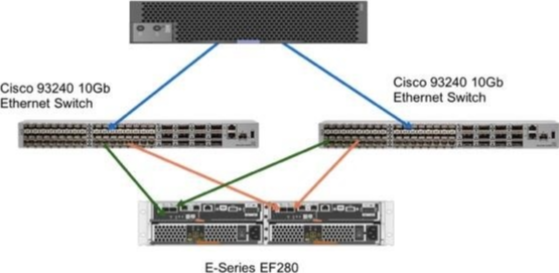01. A customer has a storage system that has been configured with multiple RAID 5 volume groups. The customer would like to reclaim capacity from the volume groups to use for a new application.
In this scenario, which action will solve this problem?
a) Shrink the size of the volume groups by using the volume group drive removal procedure, and then redeploy the drives as required for the new application.
b) Turn on thin provisioning for the RAID 5 volume groups to shrink the size of each volume, and then use the volume group drive removal procedure to reclaim the drives for the new application.
c) Consolidate free capacity for the volume group, remove the drives that are required for the new application, and let the volume group rebuild automatically.
d) Migrate all the data off each RAID 5 volume group, recreate the volume groups with fewer drives, and then migrate the data to the new RAID 5 volume groups.
02. What are two types of logical structures that volumes in the E-Series system use?
(Choose two.)
a) volume groups
b) disk pools
c) aggregates
d) volume pools
03. What is the total number of ALUA paths from the host to a volume on the EF280 that is shown in the exhibit?
a) 2
b) 4
c) 6
d) 8
04. A customer needs a system for a new solution that they are designing. They have provided you with the performance and capacity requirements.
In the NetApp Fusion UI, which workflow should you perform to help the customer?
a) Design a System Manually
b) Modify Existing Storage
c) Size and Recommend
d) Perform a Tech Refresh
05. You need to run a command from the SANtricity System Manager GUI to mark drives as native by using the CLI tool on an E-Series system that is running System Manager 11.60 or higher.
In this scenario, where would you locate this tool?
a) Help -> CLI Command Reference
b) Support -> Support Center -> Diagnostics
c) Modify Existing Storage
d) Settings -> System -> Addons
06. During normal operation, a failure was detected on an E-Series hardware component. You want to determine the location of the failed component and understand the potential recovery actions.
In this scenario, which tool would you use to accomplish this task?
a) performance monitor
b) unreadable sectors log
c) Recovery Guru
d) Host Mappings tab
07. What is the maximum number of FC host interface cards used per NetApp EF600 storage array?
a) 1
b) 2
c) 3
d) 4
08. A customer is experiencing performance issues on their NetApp E-Series system that is running with iSCSI host interface cards (HICs).
In this scenario, in which two locations in the GUI would you go to find detailed statistics for the ISCSI connections on this system?
(Choose two.)
a) Settings -> System -> View ISCSI Statistics
b) Support -> Support Center -> Diagnostics -> View iSCSI Statistics
c) Home -> View Performance Details
d) Support -> Support Resources -> Storage Array Profile
09. A company has just installed a NetApp EF600 storage array with an initial drive count of 12. A disk pool is created using all 12 disks.
Benchmark testing now shows that system performance is far less than expected. Metrics show a very unbalanced use of the two PcIe busses and drives.
In this scenario, which action addresses this problem?
a) Dynamically convert the volumes from RAID 10 to RAID 5.
b) Adjust cache block sizes to 8k.
c) Build two equally sized pools during disk pool creation.
d) Insert six drives into the first 12 slots and six drives into the last 12 slots.
10. You have two Linux hosts that must be connected over multiple paths to two NetApp E-Series systems. One with FC and the other with SAS.
In this scenario, which mutipathing driver should you use for each system to complete this task?
a) Use DM-MP for SAS and LVM for FC.
b) Use DM-MP for FC and LVM for SAS.
c) Use DM-MP for FC and SAS.
d) Use LVM for FC and SAS.
 Before you write the NetApp NCIE SAN E-Series (NS0-516) certification exam, you may have certain doubts in your mind regarding the pattern of the test, the types of questions asked in it, the difficulty level of the questions and time required to complete the questions. These NetApp Certified Implementation Engineer - SAN Specialist, E-Series (NCIE SAN Specialist E-Series) sample questions and demo exam help you in removing these doubts and prepare you to take the test.
Before you write the NetApp NCIE SAN E-Series (NS0-516) certification exam, you may have certain doubts in your mind regarding the pattern of the test, the types of questions asked in it, the difficulty level of the questions and time required to complete the questions. These NetApp Certified Implementation Engineer - SAN Specialist, E-Series (NCIE SAN Specialist E-Series) sample questions and demo exam help you in removing these doubts and prepare you to take the test.
